Wine
Wine Tasting 101: What to Expect at a Wine Tasting
November 6, 2023

There’s no wrong way to enjoy your favorite wine, but there are some tips that can enhance your enjoyment so you can get the most out of your wine drinking experience.
Drinking with Your Eyes
Clarity, Color, and Hue
The phrase “you eat with your eyes first” isn’t only used for food—it can apply to drinking, too. Before you smell, swirl, or taste the wine, you want to observe the gentle flow of wine from the bottle and into your glass. There are a few things to observe or highlight in the wine’s appearance.In order to get the best view of your wine, it’s common practice to have natural light and a white background, or simply a white piece of paper. Tilt your wine glass at various angles to observe the appearance. Some grape varieties have classic coloring to look out for (Syrah might be purple, Nebbiolo might appear light red with a brick hue, etc). The color variation might be due to the pigmentation of the grape skins or due to the maceration time. You can also tell the wine’s concentration on a scale from translucent to opaque. If you can read lettering through the liquid, it’s considered translucent. If you cannot see through the wine, it’s considered opaque.
Colors may be steady throughout the glass or become lighter toward the rim. Consistent coloration throughout is an indication of a wine’s youth whereas more variation in coloring would indicate an older wine. White wines get darker with age and red wines get lighter with age. If you observe sediment in the glass, don’t worry it’s not harmful. It’s a naturally occurring process due to either a winemaking decision in younger wines or due to the breakdown of tannins in older wines.
The Science of Swirling
Opening Wine's Aromas and Bouquet
You just sat down at home and opened a new bottle of wine, or maybe you ordered one to share at a restaurant. The first thing you do is grab the glass by the stem and start swirling. Sound familiar? You may have heard that you should swirl your wine in the glass before smelling it. But aside from looking as suave as James Bond at a party, you may be wondering what the real reason is behind this technique. “Letting the wine breathe” is a phrase thrown around frequently enough, but without much context, you might not know what that actually means.When you swirl your glass, you’re introducing oxygen and encouraging the interaction of aromatic molecules–essentially waking the wine up from its time in the bottle. When this interaction occurs, both the aroma and flavors begin to open up and bloom.
Swirling your wine also ties back to visual observation. Swirling leaves behind what we call “legs” in the wine world, or “tears”. As you swirl your wine, gravity pulls the liquid back down into the glass and a very small amount of alcohol evaporates. This creates a cascading effect that looks like tears dripping down the side of your glass.
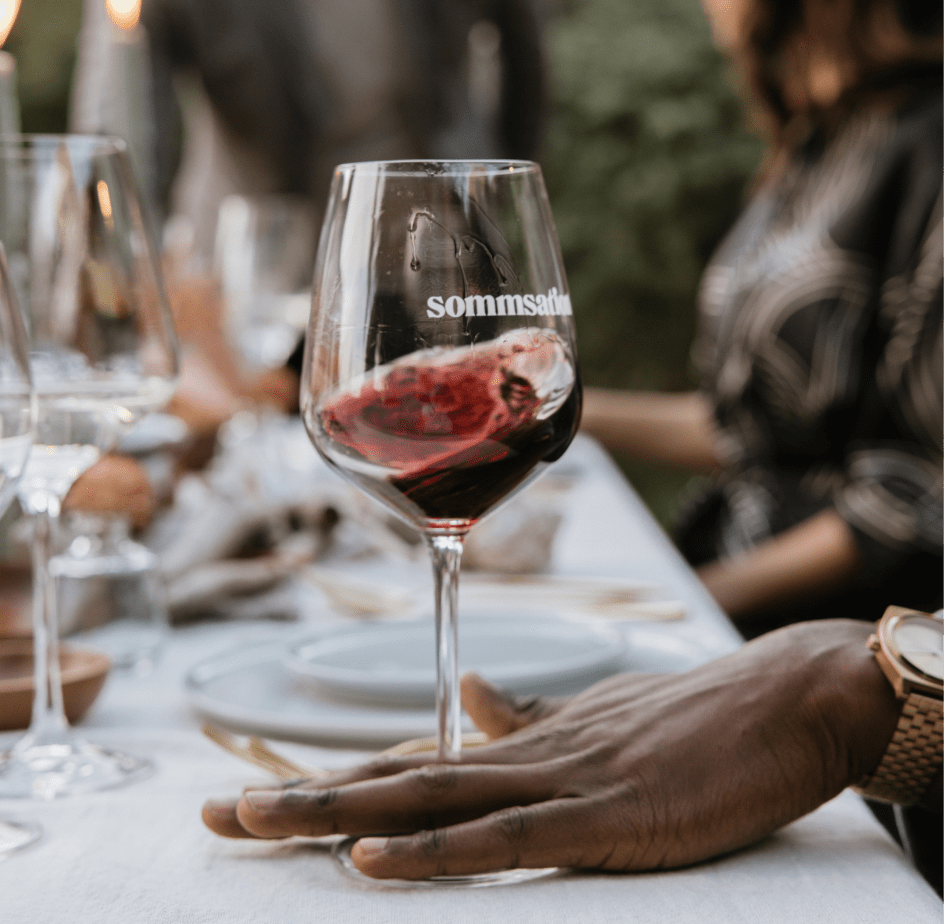
There’s a common misconception that legs can indicate a wine’s quality. However it’s actually an indication of the viscosity of the wine (the Marangoni Effect explains the science behind the structure of legs). The viscosity is defined by the alcohol content and residual sugars. Wines with higher alcohol content and less residual sugar will have fast moving legs. Wines with lower alcohol content have more residual sugars and the legs will move more slowly indicating a more viscous liquid in the glass.
Zinfandels, like Opolo Vineyards’ 2021 Mountain Zinfandel, typically exhibit a lot of legs after swirling due to their higher alcohol content. The color of a Zinfandel will be different than that of a Cabernet Sauvignon due to the nature of the different grapes themselves, as well as how they’re handled in the winery—you can see the legs move at a faster speed because of the higher alcohol content.
Enjoying the Aromas
Engaging Your Sense of Smell
Now that you’ve swirled your wine and the aromas and bouquet have opened up, it’s time to engage your sense of smell. Pro tip: smell your wine with a cracked mouth, allowing the air to circulate through your nose and out of your mouth. This ensures your olfactory system is working at its most efficient. If you need assistance resetting your sense of smell, you can neutralize present odors and scents by placing coffee beans nearby.Did you know? The human nose is designed so that one nostril is more dominant than the other. This dominant nostril will actually change throughout the day, so try smelling with the glass angled to the right then left to see which you are getting more aromas from.
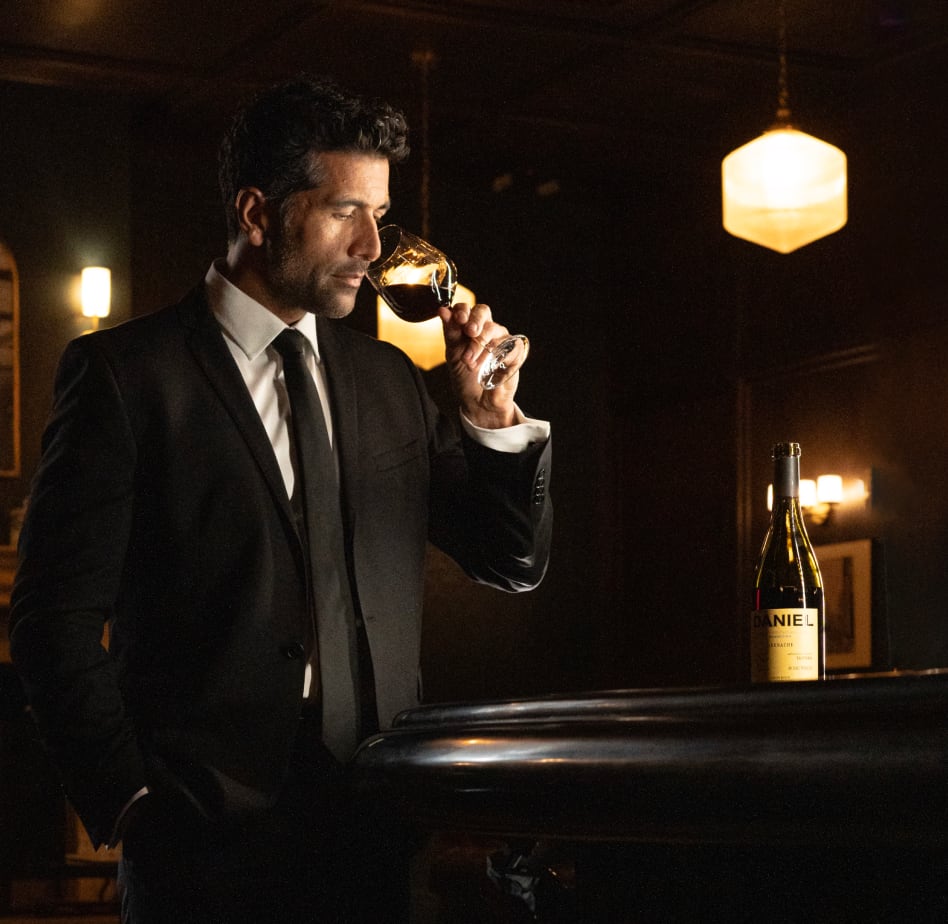
When you’re looking to identify specific aromas in wine, it’s typical to compare them to other tangible organic matter–i.e. fruit, grass, or herbs. When we detect those aromas in wine, there’s a scientific reason behind it, specifically organic chemistry. When you get notes of citrus peel on the nose, it’s because you’re identifying an aromatic compound (terpenes–specifically Limonene and citral) the wine has in common with citrus peel.
If you’re struggling to separate the aromas when you’re swirling, place your hand over the top of the glass. The phenolics will continue to be lifted out of the wine, but without anywhere to go, the aroma will concentrate in the trapped space. Lift your hand quickly and inhale deeply. The wine’s primary aromas and bouquet of secondary/tertiary aromatics will be much more noticeable and easier to detect.
Another pro tip: Always smell your wine before and after you swirl to take notice how the exposure to oxygen impacts the wine in real time. If you notice a substantial difference in the aroma after a quick swirl, sit back and enjoy how this wine quickly evolves in the glass. If you don’t notice a difference, it might be time to break out a decanter or aerator to allow the wine to breathe.
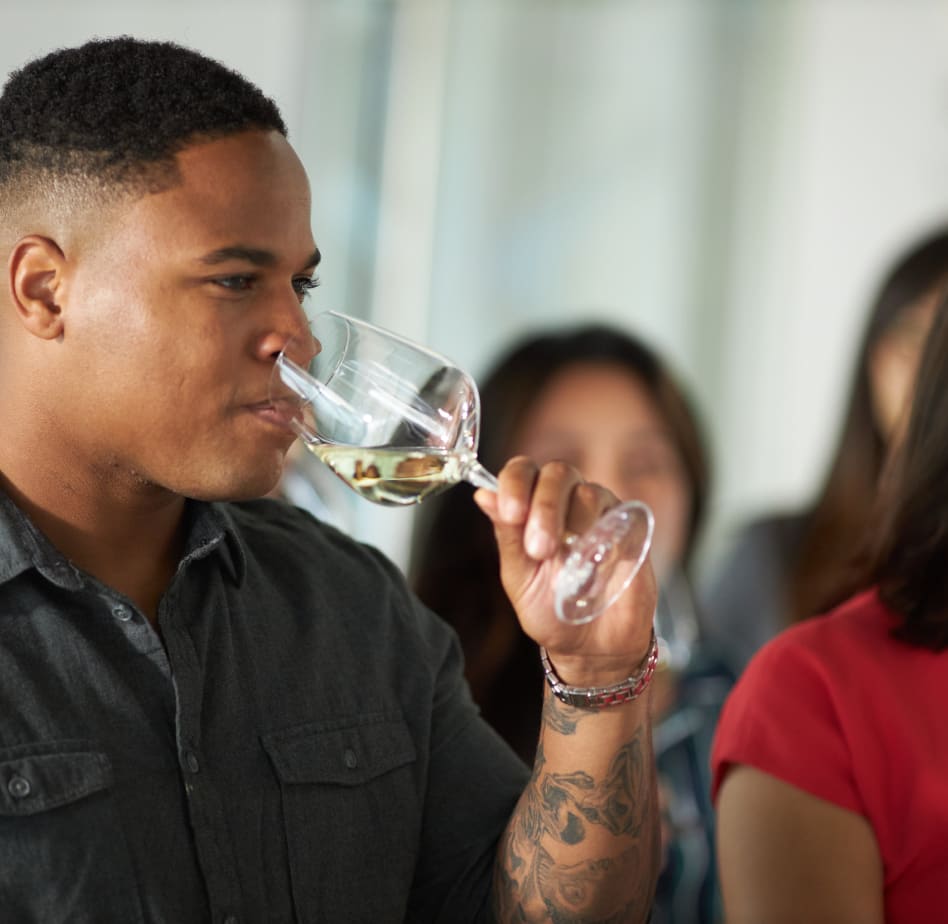
Tasting the Wine
Now is the part you’ve (probably) been waiting for: tasting your wine. Take a small sip to start and swish it around your mouth like mouthwash to coat and prepare your palate. Make sure the wine touches all corners of your mouth and tongue to taste the different elements of sweetness, bitterness, acidity, heat, etc.With the first sip, your mouth is adjusting to the wine’s acidity levels. All wine is acidic—the average pH scale of wine ranges from 2.9 to 3.9. It can drop even lower or climb higher, but the majority of our wines fall into this range. Is your mouth watering yet? How much and how quickly saliva gathers under your tongue will hint at just how acidic your wine is. The more you salivate, the higher the acid, and the lower on the pH scale your wine is. Some common more acid driven wines are Riesling, Sauvignon Blanc, and Pinot Noir. The cooler the growing climate is, the more acid driven the wines will be.
Next, take a second sip. This sip is often thought of as the first true taste you’ll experience of the wine. Wines are often considered to be better after the second sip, as your palate adjusts to all the subtle nuances in the glass. What do you notice? With the first sip out of the way, you can work on identifying the flavors and exciting layers of the wine. Analyze the wine as best as you can. Do the flavors remind you of fruit or earth? What kind of fruit? Does the fruit taste tart, or is it ripe? Or is the character even overripe or baked? More tart equals less ripe, and vice versa. This is half the fun of wine tasting—let your nose, mouth, and mind relax as you search the depths of your memories for something you’re reminded of with each sip.
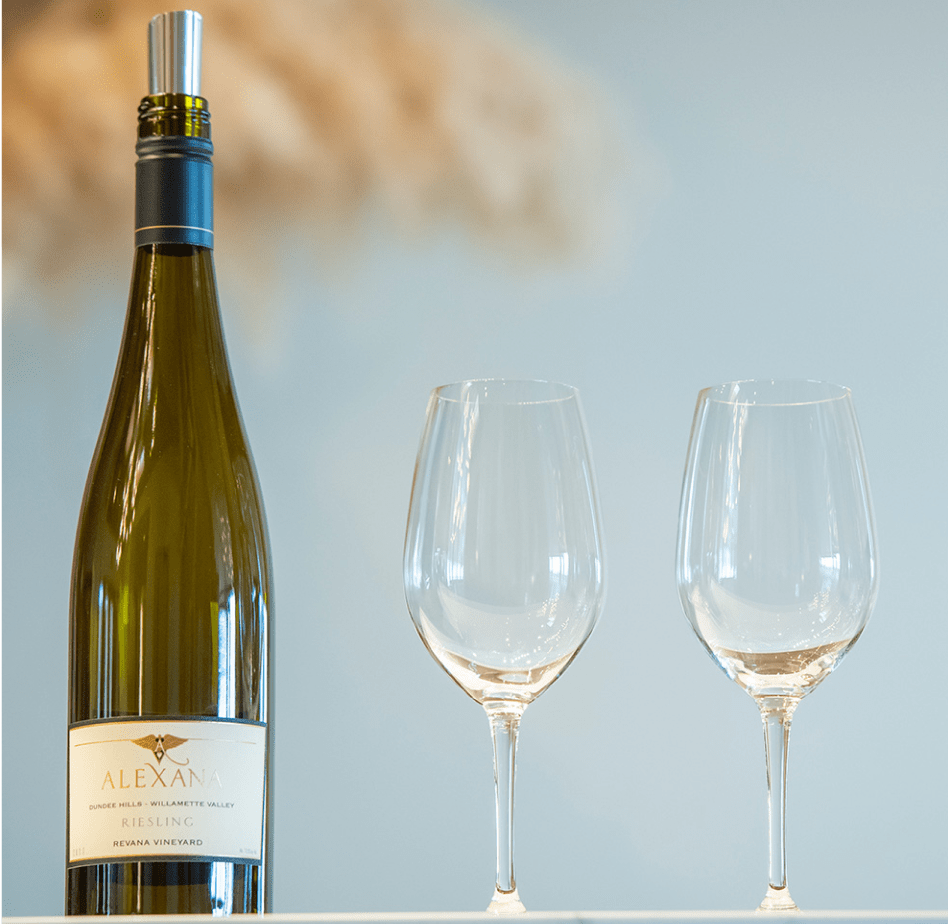
Tasting after you smell is always important because aromas and flavors don’t always match. As the wine opens up and breathes more, the aromas and flavors can change in the glass.
For example, while the nose of the 2017 Alexana Estate Riesling might have some petrol notes to it, the palate of lush ripe peaches, honeysuckle, and candied ginger will surprise you with its mouth-watering flavor. If you judge a wine strictly by its smell, you’ll be missing a substantial part of the picture. With some significant age to this white wine, it will continue to open up in the glass as you’re enjoying it. The first sip could present flavors of ripe fruit and ginger, but by the last sip, the wine will mellow into a more harmonious version of itself.
Enhancing Your Enjoyment
Here are a few more tips from our team of sommeliers to help you savor the experience—and set you apart from the rest.
Temperature Control
Make sure your wine is being stored, served and enjoyed at proper temperatures–taking into consideration the weather and the temperature in the room. The colder the wine, the more muted the flavors as the colder temperature slows down the interaction of aromatic molecules in your glass. Sparkling and white wines are typically served around 40°F-45°F. Red wines are typically served at cellar temperature between 55°F–65°F. Want to know more? Get all the details in our blog about chilling wine.Avoid Outside Aroma Interference
Any detectable odors or strong smells can impact the perception of your wine. Try to avoid wearing cologne, perfume, scented lotions or strong scented hair products when going to a wine tasting. Skip floral arrangements that have a strong aroma such as lilies, lavender, roses, or jasmine. And while candles are excellent for setting the mood, ensure the ones you select have little to no scent.Sensory Deprivation
If you’ve seen Dining in the Dark events, you know that when you remove one of your primary senses, the others compensate. If you’re trying to give your nose or sense of taste a little boost, try closing your eyes.Palate Reset
If you’re tasting several wines in rapid succession, your nose and mouth can experience something called palate fatigue, meaning your senses have been overwhelmed. A good way to reset your nose is to smell your own skin (barring your use of scented body wash or lotion). It might sound strange, but it works. The easiest way to do this is to bring the crook of your elbow to your nose as if you were going to sneeze. Inhale deeply through your nose and exhale through your mouth.If your palate is in need of a reset as well, have a bite of something neutral. White bread or plain crackers work well for this. Oyster crackers typically get the job done. Always follow with a sip of water before moving on to the next wine. In fact, keep a glass of water on hand during your tasting to maintain an adequate level of hydration. Our sommeliers recommend one glass of water per glass of wine.
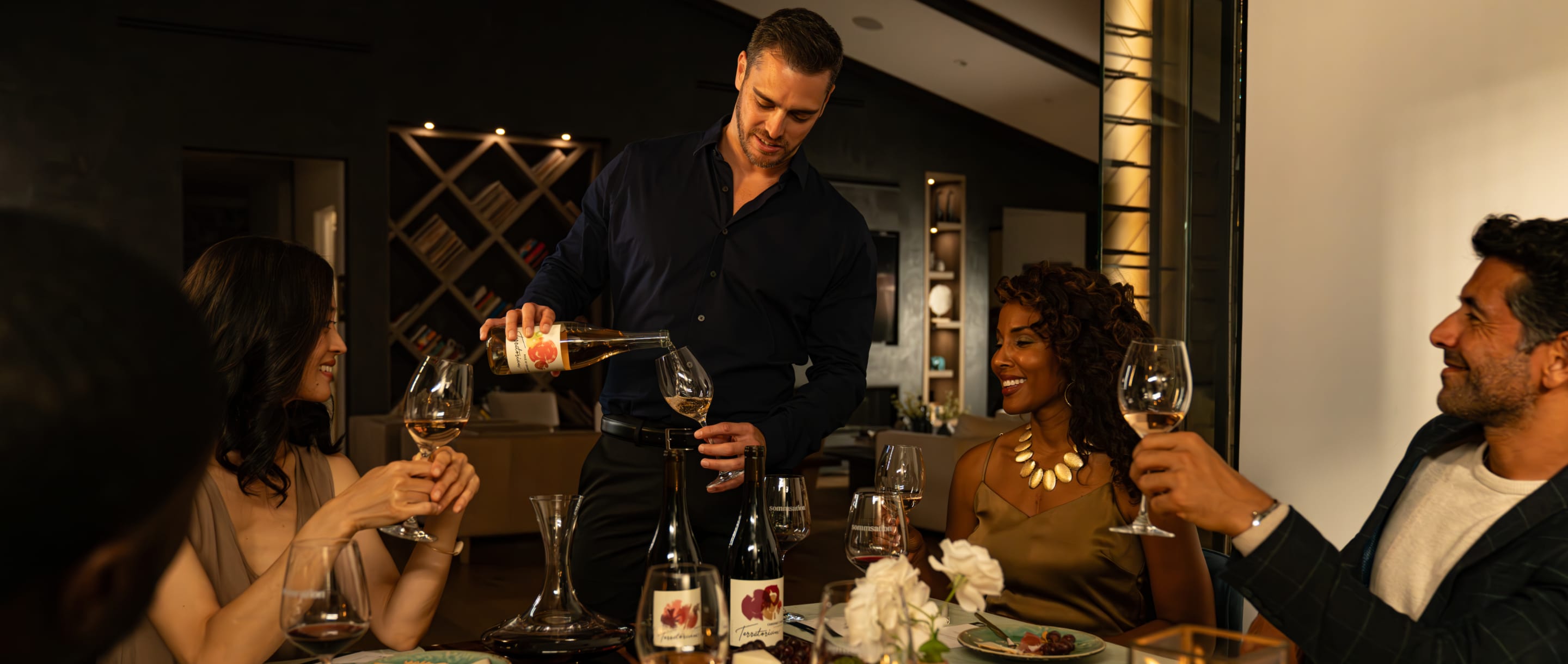
Planning a Wine Tasting
Sommsation at Your Service
Ready to put your new skills to the test? We have over 130+ unique wine tasting experiences, all curated and led by one of our 30+ sommeliers. Getting started is easy—simply pick your tasting, choose your date and guests, and we’ll handle the rest. Our concierge takes care of the planning and execution, and your personal sommelier for the evening will guide you through the experience, including the winery’s history, the wines, and food pairing recommendations.So sit back, relax, and get ready for an incredible tasting experience.